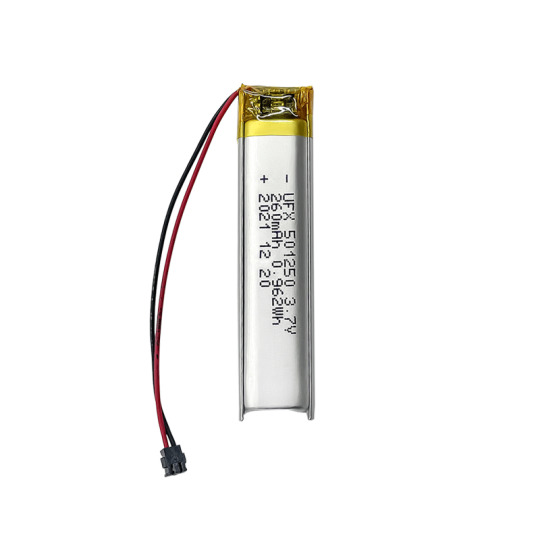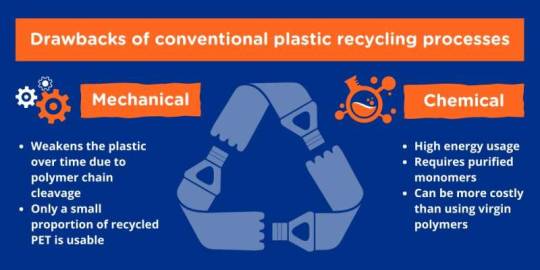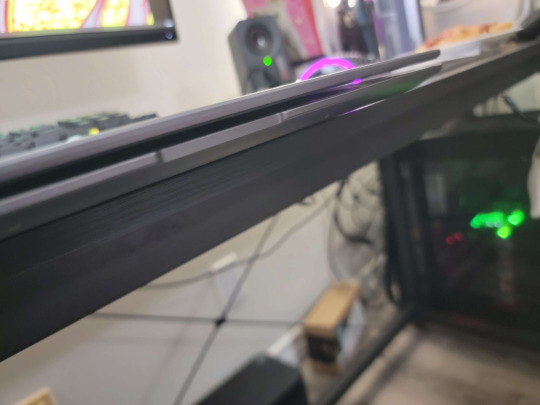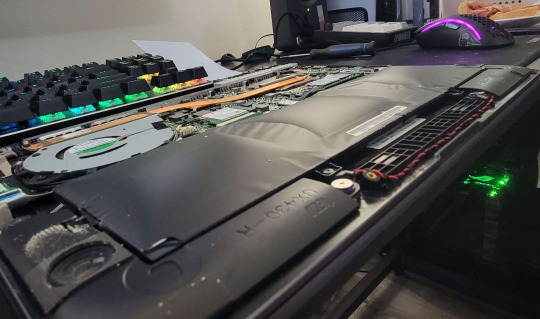#lithium-polymer batteries
Explore tagged Tumblr posts
Text

Researchers develop polyurea membranes for lithium recovery from waste batteries
In a study published in the Journal of Membrane Science, a research group led by Prof. Wan Yinhua from the Institute of Process Engineering (IPE) of the Chinese Academy of Sciences propose a new zone-regulated interfacial polymerization strategy, aiming to fabricate acid- and alkali-resistant nanofiltration (NF) membranes with high separation selectivity for the lithium recovery from waste lithium batteries. The rapid expansion of the new energy industry has driven a surge in demand for lithium resources, highlighting the need for effective recycling of spent lithium batteries. Green and efficient nanofiltration (NF) technology is emerging as a key solution for sustainable lithium recovery. However, conventional polyamide NF membranes face challenges such as structural degradation under acidic and alkaline conditions, which compromises their separation performance.
Read more.
#Materials Science#Science#Batteries#Waste#Lithium#Lithium ion batteries#Polymers#Polymerization#Interfaces#Membranes#Materials processing
13 notes
·
View notes
Text
Specifications:
Voltage: 3.7 V
Capacity: 2000 mAh
Model: 523450
Battery Chemistry: Lithium Polymer
Battery Type: Rechargeable Power Battery
Dimensions: 5.2mmx34mmx50mm
2 notes
·
View notes
Text
#Lithium polymer battery#Buy High Quality LiPo battery#Buy Lithium Polymer#LiPo Batteries Online in India#Lithium Polymer batteries#Lithium Polymer Battery Technology#Li-Polymer battery#Polymer-based battery
0 notes
Text

Lithium Polymer Battery vs Lithium ion Battery
Explore the world of lithium polymer batteries in this comprehensive blog post. Whether you’re an electronics enthusiast or seeking a reliable power source, this guide covers the advantages, types, applications, handling tips, and debunks common myths. Gain valuable knowledge to empower your understanding of this advanced technology and enhance your device experience. Let the exploration begin! Learn more info. check out here: https://www.redwaypower.com/lithium-polymer-battery-all-you-need-to-know/
0 notes
Text
Lithium-ion Batteries from Drones Might Find Second Lives in Less ‘Stressful’ Devices - Technology Org
New Post has been published on https://thedigitalinsider.com/lithium-ion-batteries-from-drones-might-find-second-lives-in-less-stressful-devices-technology-org/
Lithium-ion Batteries from Drones Might Find Second Lives in Less ‘Stressful’ Devices - Technology Org
Taking flight can be stressful — especially for a lithium-ion battery that powers a drone. Too much strain on these cells causes damage and shortens a device’s lifespan.
Research in ACS Energy Letters shows the potential to improve batteries in aerial electric vehicles that take off and land vertically. The team developed a new electrolyte to address these challenges and said the “stressed out” batteries could also have second lives in less strenuous applications.
This is an example of an FPV drone. Image credit: Benedikt Zinn via Unsplash, free license
Lithium-ion batteries (LiBs) have exploded in popularity thanks to their ability to pack a large amount of power in a relatively small, light package. But they aren’t perfect, especially when a lot of that power needs to be drawn from the battery cell quickly.
For example, drones put a high strain on their batteries during takeoff. While hobby drones traditionally use lithium-ion polymer batteries instead of LiBs, the latter’s high energy density is better suited for heavier-duty drones, such as those that deliver cargo to remote locations. To better understand how high-strain events like liftoff can affect LiB stability, Ilias Belharouak, Marm Dixit and colleagues “stressed out” a set of LiBs and investigated how their performance changed.
The researchers manufactured a set of LiB cells containing a specially designed, fast-charging and discharging electrolyte. Then, they drained 15 times the battery’s optimal capacity, the total amount of energy it could store, for 45 seconds. This process simulated the rapid, high-power draw, also known as a discharge, needed during vertical takeoff.
After the initial discharge pulse, the cells were further drained at a more normal discharge rate and then recharged. The team found that none of the tested cells lasted more than 100 cycles under these high-stress conditions, with most starting to show decreased performance around 85 cycles.
After being “stressed,” the researchers subjected the LiB cells to a more normal, lower rate power draw. In this experiment, they observed that the cells partially retained their capacities under low-rate conditions, but failed quickly when put under rapid current drain conditions again.
These results indicate that the LiBs typically used in drones might not have the characteristics necessary for long-term, high-stress usages, but they could be retired and meet more typical power demands in other applications, such as battery back-ups for power supplies and energy-grid storage. The researchers say that more work is needed to develop alternative battery technologies that are better suited for vertical takeoff and other high-power-demand applications.
Source: acs.org
You can offer your link to a page which is relevant to the topic of this post.
#applications#batteries#battery#cell#Cells#devices#drone#drones#electric vehicles#electrolyte#electrolytes#energy#energy density#Events#flight#Fundamental physics news#grid#how#it#LESS#Light#Link#lithium#lithium-ion#Lithium-ion batteries#Optics & photonics news#Other#performance#polymer#power
0 notes
Text

Guangdong Ufine New Energy Co., Ltd. A lithium polymer battery manufacturer in China focus on lithium battery R&D and provide high quality lithium ion battery. Whatsapp: +8615913641520 E-mail: [email protected]
0 notes
Text
How to Choose the Right 3.7V Battery for Your Device
Choosing the right battery for your devices can make a huge difference. It can improve your efficiency, productivity and do more by keeping your devices powered up for a long time.
There are many types of batteries you can choose from. And, 3.7v battery is one of the best ones. They are a type of battery that is widely used in electronic devices. People can use it to supply power to their devices and gadgets as they are rechargeable. You can easily recharge it many times.
They are also known as 3.7v lithium polymer battery and can be used to supply power to devices for long periods of time.
The Benefits of Using a 3.7v battery
Before you choose a 3.7v battery, it is important to understand the benefits of using it. It will help you make an informed decision. Plus, it will also help you understand how to use it and get the most out of it.
Here are the benefits of using it:
Quick Recharge – One of the best things about these types of battery is that you can quickly recharge it. They are rechargeable and can be recharged hundreds of times. They are used in wide range of portable devices like mobile phones and cameras.
Long-lasting – These types of batteries are also long-lasting. Meaning, they can provide your devices with power for a long time. And, the batteries are very durable.
Cost -effective – The 3.7v batteries are very cost-effective as they are available at affordable price. Also, you can buy 3.7v lithium polymer battery online at a great price.
These are some of the best reasons why 3.7v battery is a great option.
How to Choose a 3.7v Battery?
When it comes to choosing a 3.7v lithium polymer battery, there are a few things you need to consider. It includes:
Size- 3.7v lithium polymer battery is small and compact in design. Due to its small size, it is easy to use and carry around. But you can choose the battery in different sizes. It all depends on your requirements.
Energy Density - 3.7v lithium polymer battery offer high energy density, which is why it can provide power supply to devices and gadgets for a long time. When looking for a 3.7v battery, make sure that you choose the one with high energy density.
Fast Recharge – Lastly, you should choose a battery that can charge fast. But keep in mind that fast charging can put a lot of pressure on the battery and even damage it. Which is why, it is important to choose a battery that can charge fast without putting pressure on the battery or the device.
The Bottom Line
3.7v lithium polymer battery is an excellent option for powering up devices and gadgets. They offer an easy and convenient way of supplying devices with power. It is important that you choose the right battery so that you can enjoy greater efficiency. Look for a 3.7v battery that has high energy density, durability and fast charging capacity.
0 notes
Text
#Prismatic Lithium-ion Battery in Noida#Prismatic Lithium-ion Battery in India#Polymer Battery in Noida#Lithium-ion Battery Pack#LiFe PO4 Battery Pack
0 notes
Text
When I go to the big alternative energy conferences, people ask me: what’s the most recyclable battery out there? Is it lithium-ion? Lithium-polymer? Lithium-iron-phosphate? No, friends: it’s Home Depot.
Let me explain. Stealing batteries from Home Depot is a renewable source of energy. Wow, I guess that was actually pretty simple. Allow me to expand further: the definition of renewable is that it comes back after it’s gone, right? When you fill the false lining on your jacket with flashlight D-cells, or just stuff a bunch of Evereadys down the back of your pants and constipated-penguin-walk your way off of the show floor while pretending to yell at “your wife” on “your smartphone,” those batteries will be back on the shelves the very next day, like it never even happened.
Unlike solar, too, this energy source is available all the time. In fact, it’s quite a bit easier to harvest this power at night, because the parking-lot security guard has to take his break around then.
Sure, it’s not a perfect solution. Sometimes they move them around, or they put a camera near the batteries. We’re going to need to develop new strategies to extract this energy, and it will take cooperation from everyone in society (for instance, a big guy who can stand around the paint aisle and block the loss-prevention lady.)
Overall, we need to use less energy, because I am getting tired of driving to the store every day just because I had to use an entire shipping crate full of double-A batteries to boost my car. I’m doing my part, by only using solar calculators to compute my profits from selling the excess batteries on Kijiji under the name of a local tough-on-crime politician.
192 notes
·
View notes
Photo

Technology transforms plastic waste bottles into polymers for lithium-ion batteries
A team of A*STAR scientists has successfully upcycled waste polyethylene terephthalate (PET) plastic into polymer electrolytes, which are key components for safer lithium-ion batteries (LiBs). The study is the first known report of a working lithium-ion battery assembled using polymers upcycled from PET plastics, which are used to make plastic bottles.
The study was published in Journal of Materials Chemistry A in November 2022.
Plastic waste is a mounting problem in the world today, and it is set to grow bigger with the rising demand for plastics. 460 million tons of plastics were produced globally in 2019, but only 9% are recycled, with the remainder either being incinerated or disposed in landfills and the environment.
Plastic waste is conventionally recycled through mechanical and chemical processes, which have their drawbacks. For mechanical recycling, only a small proportion of recycled PET can eventually be used, as their physical properties degrade with each round of recycling due to polymer chain cleavage. Chemical recycling involves high energy usage, requires purified monomers and can be more costly compared to using virgin polymers.
Read more.
#Materials Science#Science#Lithium ion batteries#Waste#Polymers#Plastics#Polyethylene terephthalate#Batteries#Electronics
23 notes
·
View notes
Text
#Lithium polymer battery#Buy High Quality LiPo battery#Buy Lithium Polymer#LiPo Batteries Online in India#Lithium Polymer batteries#Lithium Polymer Battery Technology#Li-Polymer battery#Polymer-based battery
0 notes
Text
Hoverboard Lithium Batteries Factory Wholesale
The battery is one of the most important part of Hoverboard, and choosing a high-quality Hoverboard battery can greatly improve the usage time and experience. Like most other electric vehicles, there are a few different types of batteries to consider. If you’re in the process of selecting one of the new hoverboard, then you’ll want to consider what kind of battery you’re getting. Learn more info. check out here: https://www.redwaypower.com/hoverboard-batteries/
#60V 100Ah Lithium Battery#Lithium Battery Explosion#What Is Lithium Polymer Battery?#Common Causes of Lithium Battery Explosion#Hoverboard Lithium Batteries Factory Wholesale#CCA in a jump starter
0 notes
Text
Lithium-ion batteries have ruled for decades. Now they have a challenger. (Washington Post)
Excerpt from this story from the Washington Post:
After decades of lithium-ion batteries dominating the market, a new option has emerged: batteries made with sodium ions.
Scientists have been researching alternatives to lithium for years. Much of the world relies on this kind of battery, but the mining and processing of its materials can be harmful to workers, local communities and the environment.
Sodium has recently emerged as one of the more promising options, and experts say the material could be a cheaper and more environmentally friendly alternative to lithium.
In the past few years, sodium-ion battery production has increased in the United States. Last month, sodium-ion battery manufacturer Natron Energy announced it would open a “gigafactory” in North Carolina that would produce 24 gigawatt hours of batteries annually, enough energy to charge 24,000 electric vehicles.
But sodium-ion batteries are still early in their development compared with lithium-ion, and they have yet to hit the market on a massive scale.
“It’s unlikely sodium-ion could displace lithium-ion anytime soon,” said Keith Beers, polymer science and materials chemistry principal engineer at technical consultancy firm Exponent.
Here’s what to know about these batteries.
How sodium-ion batteries work
There are many types of sodium-ion batteries, but the ones that will be manufactured in North Carolina are produced in the same way as lithium-ion batteries, just with different ingredients. Instead of using expensive materials like lithium, nickel and cobalt, these will bemade of sodium, iron and manganese.
In a battery, ions move between electrodes during a charging and discharging process to generate electricity, explains Alvaro Acosta, a senior director at the solar developer Lightsource bp. In a sodium-ion battery, sodium ions carry the charge, and the negative electrode is made up of common materials like iron, carbon and nitrogen. Natron’s batteries use iron and manganese for their negative electrodes.
The biggest limitation of sodium-ion batteries is their weight. Sodium weighs nearly three times as much as lithium, and it cannot store the same amount of energy. As a result, sodium-ion batteries tend to be larger.
Jens Peters, an economics professor at the University of Alcalá in Madrid, said the energy density could be improved over time in sodium-ion batteries. But, he added, “what we found out so far in our assessments is that it is not a game changer.”
Sodium-ion batteries are touted to be the environmentally friendly alternative to their lithium-ion counterparts, thanks to their raw materials. Sodium, iron and manganese are all abundant elements on the planet, so they require less energy to extract and cost less.
“Everyone knows that lithium-ion batteries are the pulse of mobile phones, transportation,” said Yang-Kook Sun, professor of energy engineering at Hanyang University in Seoul. “The issue over lithium-ion batteries is that they use highly expensive materials like lithium, nickel and cobalt.”
6 notes
·
View notes
Text
"Hey, the laptop feels weird."

So, Sander's lid isn't closing flush. On closer inspection, the touchpad sure is popping up out of the keyboard by about the same amount as that gap you see in the above picture, so roughly 1/8".
"Ah, fuck." I think to myself. "That's probably a spicy pillow."
So, I flip Sander over and break out my handy-dandy T5 Torx bit to take the bottom of the case off. I ease my way in by working at all of the screws at once. I am careful. I am cautious...
... And I jump 3 feet out of my skin when the plate suddenly releases with a resounding CRACK:

That 1/4" gap you see there? That's not the lid. That's the bottom plate of the laptop, pushed up by the swollen chunk of chemical oh-no underneath it now that there are no screws to keep the delinquent battery subdued. Normally there are sets of clips along the inner edge of the chassis that hold the plate on, but they were no match for the Spicy Pillow.

There he is! Sander Cohen's undoing in all its glory. If you've ever wondered what a 50Wh 3-cell lithium-polymer battery looks like once it's going spicy, now you've seen it! :D
A few hours later and he's now recovering from surgery and doing quite well, though he will forever be tethered to the wall AC now that he's got no cell in there. I'm glad, because I'd just finished wiping the machine clean and setting him up for BabyCat to use for her schoolwork and some games. @_@; Her phone recently shattered (wasn't her fault either, the poor thing) and this was a way of cheering her up, and it almost went so horribly wrong.
#computer stuff#Fara speaks#story time#computer problems#Spicy pillow#Sander Cohen the Laptop#photo post#Kudos to this chassis though it snapped right back into shape
15 notes
·
View notes
Video
youtube
Stay Charged On-The-Go with Our Built-in Charging Cables Portable Power Bank 10000mAh
Looking for a reliable power source for your devices? Our Emergency External Power Bank is here to keep you connected when you need it most. Crafted with durable Glass mirror+ ABS material and featuring a powerful 10000mAh Li-Polymer cell type, this power bank ensures long-lasting performance for your mobile phone, tablet PC, camera, and more.
Equipped with multiple output interfaces including Lightning, Micro, and Type-C, as well as versatile input options such as Micro-USB and Type-C, this power bank offers convenient charging solutions for a variety of devices. The built-in smart chip and Lithium Polymer battery guarantee safer charging by automatically matching the current for your devices, while the strong suction cups provide stable charging without the risk of falling off.
Experience lightning-fast charging with the 22.5W super-fast charge feature, supporting Huawei SCP for rapid charging with a 5A cable. Although it doesn't support LED lights, it does feature a display for easy monitoring of charging status. Available in sleek Black, White, and Blue colors, this power bank is a must-have tech accessory for those who value convenience and reliability.
Don't let low battery levels disrupt your day. Stay connected, stay charged, and stay ahead with our Built-in Charging Cables Portable Power Bank. Whether you're on the go or in an emergency situation, this power bank is your ultimate companion for convenient charging. #PowerBank #FastCharging #StayConnected #TechAccessories #StayCharged #BatteryLife
Invest in your power needs with our Portable Power Bank and never worry about being disconnected again. Get yours today and experience the convenience of reliable charging wherever you are. #OnTheGo #MustHave #ConvenientCharging #PowerUp
2 notes
·
View notes
Text
What are The Top Benefits of LiPo Batteries for Portable Electronics
LiPo batteries also known as lithium polymer battery, is one of the best options for portable devices. It can be charged multiple times and they are portable. This makes them an excellent choice for portable devices like mobile phones and laptops.
Understanding how it works and the benefits of using it can help you make an informed decision. Like finding the right LiPo battery. You will find LiPo batteries from different companies. But it is important to choose the right supplier to get the best products.
Find out more about lithium polymer battery.
What is a LiPo Battery?
A LiPo battery is a kind of rechargeable battery made of multiple cells. They have the capacity of store large amount of energy. This ensures that they will last for a long time. Mobile phones need these kinds of batteries so that users can enjoy using their devices without any hassle.
In addition, LiPo batteries are designed in a way that makes them lightweight and compact. Again, these features are perfectly aligned with the modern lifestyle.
Perks of Using a LiPo battery
Using LiPo battery AKA lithium polymer battery is an excellent option for various reasons. If you are looking for a reliable battery option for your mobile devices, LiPo battery is for you.
Here are the benefits of using a lithium polymer battery:
They Are Relatively Inexpensive
LiPo batteries are relatively inexpensive. If you are a budget-conscious consumers then it will make a good choice for you. They are easily available online and you can quickly order them at a great price. They are also durable, and will last for a long time. It offers a very affordable solution.
Easy to Recharge
One of the best things about batteries like LiPo battery is that are rechargeable. Meaning, you can charge them hundreds of times. They are an excellent option for long-term use. You can easily recharge it whenever you need it. And, you can do it anywhere you can find a charging point.
It Can Power Multiple Devices
LiPo batteries can be used in multiple devices including mobile devices like cellphones, laptops, cameras and more. They are versatile and easy to use. This makes them an excellent option for people who want more flexibility.
They Are Eco-Friendly
LiPo batteries are green as they are non-toxic and don’t contain any heavy metals. This is different than usual batteries that do actually contain metals. Since they are eco-friendly, they are less likely to damage your device as well. It is built with highest standard for greater safety and security.
They are Durable and Long-lasting
One of the things that make LiPo batteries last longer is its capacity. Meaning, they have higher voltage than other batteries types. With a lithium polymer battery, you can power your devices for a longer period of time. Charge it and you can take your portable devices like phones with you on a long journey.
Additionally, LiPo batteries also last longer as they are very durable. They have longer lifespan as they don’t get damaged that easily. It will save you cost in the long run as well.
They are Easily Available
Other thing about the lithium polymer battery is that they are easily available online. You can easily order them online and have it delivered at your doorstep. All you have to do is find the right battery that matches your needs, from the brand that you like.
LiPo batteries are common. Therefore, you will find them easily from different brands. But not all brands can assure quality and reliability. Which is why, you have to choose a brand that combines quality, durability and affordable price together. And, you can find a good brand by looking for the rights things. For instance, the company should have good reviews, good track record, reliable delivery solution and others.
The Bottom Line
A lithium polymer battery can help you keep your devices powered well and for a long time. These types of batteries are more reliable and flexible than other types of batteries. They are easy to use, and can be used on multiple devices, both portable and stationary. With the right battery choice, you can easily power-up your devices and enjoy using them without worrying anything.
Find your LiPo battery today with the right brand.
0 notes